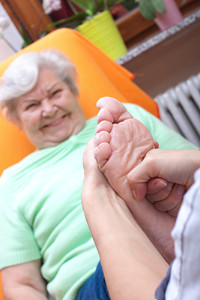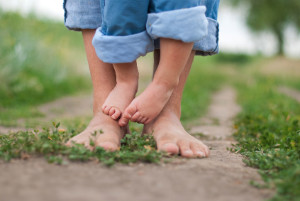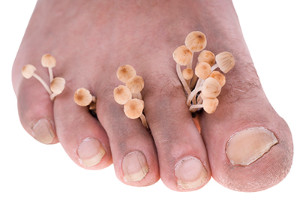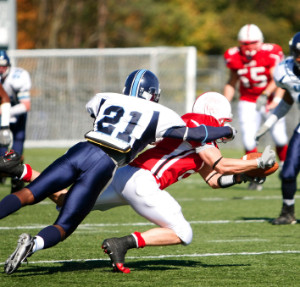
While proper foot care is important for everybody, senior citizens have the tendency to be more susceptible to certain foot conditions. The elderly should therefore be well informed about any problems that may arise and about what they can do to properly avoid or treat them.
Some of the most common foot problems seniors are susceptible to include foot ulcers, ingrown toenails, fallen arches, and fungal nails. A foot ulcer is an open sore on the foot and can be a result of diabetes and decreased sensation in the feet. An ingrown toenail is defined as when the nail grows into the side of the toe. Fallen arches are indicated by the instep of the foot collapsing. A fungal nails is a condition that results in deformed and discolored toenails.
In order to avoid these conditions it is recommended that the feet be inspected by the patient on a regular basis. If these inspections are carried out routinely, there is a good likelihood that problems can be identified before they become severe, or can even be avoided altogether. If any abnormality is discovered, it is important that the individual consult a podiatrist for diagnosis and information on treatment options.
Proper foot hygiene is also important. Making sure that you always have clean, dry socks on can be a major deterrent to many different problems including bacterial infections, foot odor, and certain types of fungus. Wet feet are a major cause of many of these problems. If your socks get wet, it is important to change them. Walking around in wet socks may not only lead to various infections, but can irritate the skin and result in a number of various complications. Clean, dry feet are less likely to be affected by fungal and other infections.
As people age, the fat present on your feet begins to deteriorate. The protective nature of this fat keeps the feet healthy by providing a barrier between your bones and the ground. This also aids in giving the skin on the feet a certain amount of elasticity. This is one factor that causes elderly people to develop some serious foot issues. Foot moisturizers can be helpful to avoid certain problems associated with this. However, water-based moisturizers do not work as well for elderly people as they do for the young. Instead, it is more effective to use an emollient instead. An emollient is effective because it binds the water in the foot, keeping it from becoming absorbed too readily which will result in dry skin. Emollients also have a special property called occlusion, which provides a layer of oil on the skin. This layer prevents the foot from drying up and can be very effective in treating dry skin disorders. If you can keep the skin on your feet healthy, this will substantially reduce the number of foot problems you will encounter in old age.
Proper footwear is another way to keep feet healthy. Shoes that fit well and provide proper support help prevent ingrown toenails and fallen arches.
Certain medical conditions such as diabetes or poor blood circulation increase the risk for foot issues. For individuals with any of these conditions it is extremely important to conduct regular foot inspections to make sure that there are no sores or infections present.
 Taking care of your feet is instrumental in preventing potential injury, especially as you get older. The following are some tips on how to properly care for your feet. It's common among the elderly to suffer from both dry skin and fungal infections, especially toenail fungus. To tackle dry skin, wash your feet in warm water, dry thoroughly, and then apply moisturizer. Toenail fungus can be a burden to eliminate, so it's recommended to see a podiatrist for treatment. Choosing the right footwear can mean the difference between comfort and injury. Avoid uncomfortable and unsupportive footwear such as heels, flats, or sandals. Instead, opt for athletic shoes as these offer more support, comfort, and protection. Always ensure that new shoes fit well and provide enough toe room. Orthotics are recommended for those with flat feet or those who need a better insole. Finally, perform routine foot checks for any abnormalities or damage.
Taking care of your feet is instrumental in preventing potential injury, especially as you get older. The following are some tips on how to properly care for your feet. It's common among the elderly to suffer from both dry skin and fungal infections, especially toenail fungus. To tackle dry skin, wash your feet in warm water, dry thoroughly, and then apply moisturizer. Toenail fungus can be a burden to eliminate, so it's recommended to see a podiatrist for treatment. Choosing the right footwear can mean the difference between comfort and injury. Avoid uncomfortable and unsupportive footwear such as heels, flats, or sandals. Instead, opt for athletic shoes as these offer more support, comfort, and protection. Always ensure that new shoes fit well and provide enough toe room. Orthotics are recommended for those with flat feet or those who need a better insole. Finally, perform routine foot checks for any abnormalities or damage.
Proper foot care is something many older adults forget to consider. If you have any concerns about your feet and ankles, contact Dr. Alan J. Spector from Shore Podiatry. Our doctor can provide the care you need to keep you pain-free and on your feet.
The Elderly and Their Feet
As we age we start to notice many changes in our body, but the elder population may not notice them right away. Medical conditions may prevent the elderly to take notice of their foot health right away. Poor vision is a lead contributor to not taking action for the elderly.
Common Conditions
Susceptible Infections
Diabetes and poor circulation can cause general loss of sensitivity over the years, turning a simple cut into a serious issue.
If you have any questions please feel free to contact our office located in Point Pleasant, NJ . We offer the newest diagnostic and treatment technologies for all your foot and ankle needs.
Being a parent involves caring for your child in every way you can. You make sure they are eating the right food, being nice to others, and staying out of any trouble. However, it is also important that you are watchful of their health, more specifically their foot health. Maintaining good foot health in childhood is important in preventing later conditions in life from happening. As children continue to develop, their feet require different techniques of care. Here are some various ways in which you can help your child’s feet stay healthy.
A baby needs a lot of care and attention overall, but the importance of their feet should never be forgotten. Before a baby turns one, their feet change and develop greatly. It is important that during this time, a mother avoids putting tight socks on their child. She should also encourage movement of their feet so the baby can begin to feel more comfortable using them.
As a baby enters the toddler years of his or her life, they are begin to walk around. When your baby begins to take those first steps, it is crucial that they are wearing protective shoes on their feet. As a mother that is observant of your child’s feet, you may notice changes in them. This is completely normal as the feet are becoming susceptible to the activity of walking. It is normal for a toddler to be a bit unsteady or to “walk funny” at first.
When your child grows out of their toddler years, it is important that you begin to show him or her how to care for their feet on their own. Practice with your child proper hygiene in order to prevent foot fungus or infection. Since children are constantly on the move, it is crucial to be cautious of any accidents or injuries that might occur. If an injury occurs, it is advised that you take your child to be examined by a doctor immediately. Since your child is still growing, particular injuries can shift the way in which a bone or other important part of the foot is developing.
Babies and kids are always changing and growing. Your job as a parent is to make sure they stay healthy and making sure they are properly maintained. This involves proper foot care and making sure the feet stay healthy. Following this guide, your child can live a long and happy life.
 When it comes to picking the right shoes, children are much more different than adults. Children’s feet are still growing and developing compared to adult feet. With this in mind, it is important for parents to make sure that their children’s shoes properly fit them. If your child is having a growth spurt, they can quickly outgrow the shoes they wear even if they are relatively new. Children’s shoes should be flexible and have enough space for their toes to move around. They also need to provide good foot support and cushion for comfort. Shoes should be comfortable even after wearing them for hours. Finally, knowing when to wear the right shoe is vital. Sandals or flip-flops are fine for the beach but not for wearing all day. If your child plays sports, they need high performance shoes that can handle the stress. Parents should routinely check their children’s shoes to make sure they properly fit.
When it comes to picking the right shoes, children are much more different than adults. Children’s feet are still growing and developing compared to adult feet. With this in mind, it is important for parents to make sure that their children’s shoes properly fit them. If your child is having a growth spurt, they can quickly outgrow the shoes they wear even if they are relatively new. Children’s shoes should be flexible and have enough space for their toes to move around. They also need to provide good foot support and cushion for comfort. Shoes should be comfortable even after wearing them for hours. Finally, knowing when to wear the right shoe is vital. Sandals or flip-flops are fine for the beach but not for wearing all day. If your child plays sports, they need high performance shoes that can handle the stress. Parents should routinely check their children’s shoes to make sure they properly fit.
Making sure that your children maintain good foot health is very important as they grow. If you have any questions, contact Dr. Alan J. Spector of Shore Podiatry. Our doctor can provide the care you need to keep you pain-free and on your feet.
Keeping Children's Feet Healthy
Having healthy feet during childhood can help prevent medical problems later in life, namely in the back and legs. As children grow, their feet require different types of care. Here are some things to consider...
Although babies do not walk yet, it is still very important to take care of their feet.
Avoid putting tight shoes or socks on his or her feet.
Allow the baby to stretch and kick his or her feet to feel comfortable.
As a toddler, kids are now on the move and begin to develop differently. At this age, toddlers are getting a feel for walking, so don’t be alarmed if your toddler is unsteady or ‘walks funny’.
As your child gets older, it is important to teach them how to take care of their feet.
Show them proper hygiene to prevent infections such as fungus.
Be watchful for any pain or injury.
Have all injuries checked by a doctor as soon as possible.
Comfortable, protective shoes should always be worn, especially at play.
If you have any questions please feel free to contact our office located in Point Pleasant, NJ . We offer the newest diagnostic and treatment technologies for all your foot and ankle needs.
Athlete’s foot is an extremely contagious infection caused by a fungus that results in itching, burning, dry, and flaking feet. The fungus that causes athlete’s foot is known as tinea pedis and thrives in moist, dark areas such as shower floors, gyms, socks and shoes, commons areas, public changing areas, bathrooms, dormitory style houses, locker rooms, and public swimming pools. Athlete’s foot is difficult to treat as well because of the highly contagious and recurrent nature of the fungus.
Tinea is the same fungus that causes ringworm, and is spread by direct contact with an infected body part, contaminated clothing, or by touching other objects and body parts that have been exposed to the fungus. Because the feet are an ideal place for tinea to grow and spread, this is the most commonly affected area. It is, however, known to grow in other places. The term athlete’s foot describes tinea that grows strictly on the feet.
The most commonly infected body parts are the hands, groin, and scalp, as well as the feet. Around 70% of the population suffer from tinea infections at some point in their lives, however not all of these cases are athlete’s foot. Just like any other ailment, some people are more likely to get it than others, such as people with a history of tinea infections or other skin infections, both recurring and non-recurring ones. The extent to which a person experiences regrowth and recurrent tinea infections varies from person to person.
Sometimes people will not even know that they are infected with tinea or that they have athlete’s foot because of a lack of symptoms. However, most experience mild to moderate flaking, itching, redness, and burning. However, some of the more severe symptoms include cracking and bleeding skin, intense itching and burning, pain while walking or standing, and even blistering.
Because of the recurring nature of the tinea fungus and the athlete’s foot it causes, the best way to treat this condition is with prevention. You can take some preventative measures such as wearing flip flops or sandals in locker rooms and public showers to reduce contact with the floor. It also helps to keep clean, dry feet while allowing them to breathe. Using powders to keep your feet dry is a good idea, as well as keeping your feet exposed to light and cool air, to prevent the growth of tinea. If you do happen to get athlete’s foot, opt for using topical medicated creams, ointments or sprays. These treatments help eliminate and prevent it from coming back.
 While most fungal infections of the foot, such as athlete’s foot, are typically non-serious conditions, they can still cause red, itchy and dry feet. This can be very uncomfortable; however, it can be prevented. Keeping your feet clean and dry can prevent fungus from developing. Use talcum powder if your feet become too sweaty. Socks and stockings should be changed daily and should be breathable to prevent sweat. It is advised to change your shoes every couple of days. Shoes that are roomy and allow the feet to breathe are also recommended. Avoid going barefoot in public bathrooms, locker rooms, and changing rooms since these places can harbor fungus. Fungal infections are no fun, but they can be prevented. If you think you have a fungal infection on your foot, see a podiatrist for a diagnosis.
While most fungal infections of the foot, such as athlete’s foot, are typically non-serious conditions, they can still cause red, itchy and dry feet. This can be very uncomfortable; however, it can be prevented. Keeping your feet clean and dry can prevent fungus from developing. Use talcum powder if your feet become too sweaty. Socks and stockings should be changed daily and should be breathable to prevent sweat. It is advised to change your shoes every couple of days. Shoes that are roomy and allow the feet to breathe are also recommended. Avoid going barefoot in public bathrooms, locker rooms, and changing rooms since these places can harbor fungus. Fungal infections are no fun, but they can be prevented. If you think you have a fungal infection on your foot, see a podiatrist for a diagnosis.
Athlete’s foot is an inconvenient condition that can be easily reduced with the proper treatment. If you have any concerns about your feet and ankles, contact Dr. Alan J. Spector from Shore Podiatry. Our doctor will treat your foot and ankle needs.
Athlete’s Foot: The Sole Story
Athlete's foot, also known as tinea pedis, can be an extremely contagious foot infection. It is commonly contracted in public changing areas and bathrooms, dormitory style living quarters, around locker rooms and public swimming pools, or anywhere your feet often come into contact with other people.
Solutions to Combat Athlete’s Foot
Athlete’s foot can cause many irritating symptoms such as dry and flaking skin, itching, and redness. Some more severe symptoms can include bleeding and cracked skin, intense itching and burning, and even pain when walking. In the worst cases, Athlete’s foot can cause blistering as well. Speak to your podiatrist for a better understanding of the different causes of Athlete’s foot, as well as help in determining which treatment options are best for you.
If you have any questions please feel free to contact our office located in Point Pleasant, NJ . We offer the newest diagnostic and treatment technologies for all your foot and ankle needs.
Foot and ankle injuries are common among people who participate in sports. Several factors contribute to this. They include failing to stretch or warm up properly, not wearing the proper type of shoe and not taping or providing other types of support for the ankle or foot. The most common foot and ankle injuries suffered by people involved in sports are plantar fasciitis, ankle sprains and Achilles tendon damage or ruptures. If not treated properly, they can lead to permanent disability.
Treating these injuries is relatively simple if they are identified and addressed early. Many athletes dismiss the initial aches and pains associated with injury as just soreness or tired muscles. Their first response is usually to try to work through it. This can lead to serious problems. Many minor injuries are made far more serious when athletes continue to put strain and pressure on them. That attitude can change a mild strain into a serious strain and a minor tear into a rupture. Athletes should have unusual aches and pains evaluated by a skilled medical professional.
Plantar fasciitis is a painful injury. It is inflammation of the plantar fascia, the thick band of tissue running from the heel to the base of the toes. If left untreated, it can lead to a degenerative disease called plantar fasciosis. There are several effective treatments for this ailment. Doctors often prescribe rest, massages, stretching, night splints, physical therapy, anti-inflammatory medication, corticosteroids or surgery, usually in that order. The most effective treatment for plantar fasciitis is orthotics, which offers foot support. Surgery is occasionally used as a last resort, but it comes with the risk of nerve damage and infection and often does not stop the pain.
The Achilles tendon is the largest tendon in the body. It connects the calf muscles to the heel bone. Running, jumping and walking all impact this tendon. Two common injuries to the Achilles tendon are tendonitis and a rupture of the tendon. Tendonitis is inflammation in the tendon often caused by an increase in the amount of stress placed on it. Non-surgical treatments include rest, ice or anti-inflammatory medication. A rupture (tear) of the Achilles tendon can be treated by placing the lower leg in a cast for several weeks or with surgery. Many physicians feel surgery is the better option because it lowers the risk of re-ruptures. Both methods require 4 to 6 months of rehabilitation.
Ankle sprains are the most common sports related foot and ankle injury. A sprain occurs when the ligament holding the ankle bones and joint stretches beyond its normal range. It can be treated non-surgically with a combination of rest, ice wrapped around the joint for 30 minutes immediately after injury, compression by a bandage and elevating the ankle above the heart for 48 hours. This combination is referred to as RICE. Severe ankle sprains in which the ligaments are torn may require reconstructive surgery followed by rehabilitation.
 A broken foot has taken senior Texas Longhorns tight end Andrew Beck out for the season. Initial projections estimated that he’d only miss six to eight weeks. Beck sustained the injury during a non-contact practice event. He will be undergoing surgery for the injury. This isn’t the first time Beck sustained broken a foot, as he suffered the same injury back in February. While the Longhorns have two freshman tight ends, Cade Brewer and Reese Leitao, Leitao was suspended for the first two games of the season. Regardless, it is expected that teammate and recent transfer Kendall Moore will take Beck’s place.
A broken foot has taken senior Texas Longhorns tight end Andrew Beck out for the season. Initial projections estimated that he’d only miss six to eight weeks. Beck sustained the injury during a non-contact practice event. He will be undergoing surgery for the injury. This isn’t the first time Beck sustained broken a foot, as he suffered the same injury back in February. While the Longhorns have two freshman tight ends, Cade Brewer and Reese Leitao, Leitao was suspended for the first two games of the season. Regardless, it is expected that teammate and recent transfer Kendall Moore will take Beck’s place.
Sports related foot and ankle injuries require proper treatment before players can go back to their regular routines. For more information, contact Dr. Alan J. Spector of Shore Podiatry. Our doctor can provide the care you need to keep you pain-free and on your feet.
Sports Related Foot and Ankle Injuries
Foot and ankle injuries are a common occurrence when it comes to athletes of any sport. While many athletes dismiss the initial aches and pains, the truth is that ignoring potential foot and ankle injuries can lead to serious problems. As athletes continue to place pressure and strain the area further, a mild injury can turn into something as serious as a rupture and may lead to a permanent disability. There are many factors that contribute to sports related foot and ankle injuries, which include failure to warm up properly, not providing support or wearing bad footwear. Common injuries and conditions athletes face, including:
Sports related injuries are commonly treated using the RICE method. This includes rest, applying ice to the injured area, compression and elevating the ankle. More serious sprains and injuries may require surgery, which could include arthroscopic and reconstructive surgery. Rehabilitation and therapy may also be required in order to get any recovering athlete to become fully functional again. Any unusual aches and pains an athlete sustains must be evaluated by a licensed, reputable medical professional.
If you have any questions please feel free to contact our office located in Point Pleasant, NJ . We offer the newest diagnostic and treatment technologies for all your foot and ankle needs.